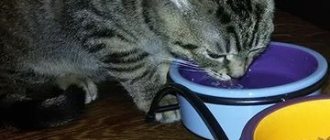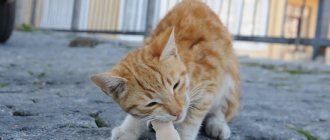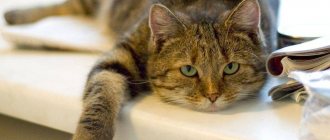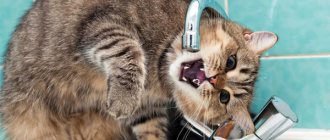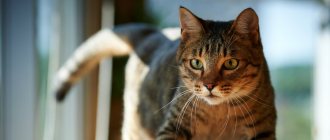There is hardly a single owner who would not observe such a phenomenon as cat vomiting. But the cat owner does not always pay due attention to what happened, considering it simply the body’s reaction to food. Yes, this happens, but it also happens that bad changes occur in the cat’s body, and this is one of the first symptoms of a serious illness. Therefore, it is better to figure out whether there is a reason to treat your pet.
Causes of vomiting in cats
There is no single reason for vomiting in cats: it can be a one-time overeating, or the presence of parasites in the body. Vomiting can occur during estrus, in a nursing cat, or in a small kitten. In any case, even a one-time occurrence requires the attention of the owner. Causes include disease, starvation, poisoning and pregnancy in the cat. The closest attention should be paid to repeated vomiting.
global $ads_google; //data-ad-slot=”2475549904″ $ads_google = empty($ads_google) ? false : true; ?> if ($ads_google == false) {?> $ads_google = true; ?> } ?>
Diseases
Here is a list of diseases that can cause a cat to burp regularly:
- chronic renal failure. Often with chronic renal failure in the morning, the ejected contents consist of empty saliva, and uremic syndrome manifests itself;
- gastroenteritis, gastritis - mucus may be visible;
- infectious diseases - the color of the vomit will be greenish;
- obstruction of the pylorus of the stomach - the animal burps white foam;
- tumors;
- parasitic infestations - the cat vomits mucus;
- inflammatory processes in the gastrointestinal tract;
- pancreatitis;
- peritonitis;
- liver diseases.
More details about the reasons will be shown by the color of the contents and accompanying symptoms. If the problem is not poisoning or a swallowed hairball, then diarrhea, constipation, swelling, and lethargic behavior of the pet may appear.
To visit a doctor, it is better to prepare information about the consistency of the vomit, its color, start time, frequency, contents of the last meals, and your pet’s behavior after regurgitation.
Vomiting fur
Sometimes a cat, for no apparent reason, spews out a ball of fur covered in drool and foam. This is a natural process of cleansing the cat’s body from hairs of fur that have entered the stomach. The wool is not digested, but clumps into clumps that cannot enter the intestines. As a result of the accumulation of hair, a special brain center begins its work, signaling the body to begin the vomiting process. Otherwise, the so-called pilobesoar - a ball of hairs huddled together in a bunch - can clog the digestive tract.
Fasting or overeating
Causes
An empty stomach can also cause stomach contents to spill out. A cat is a small predator, which is prescribed by nature to eat little and often. If a pet is starving and sees food 1-2 times a day in large volumes, or even less often, it is likely that periodic vomiting will be present in its life. A small amount of vomit will contain foam and mucous gastric secretions. The urge to vomit on an empty stomach stops immediately after access to food.
The second reason will be the opposite side of eating - overeating. Problems can happen with a full stomach, just like with an empty one. A full stomach puts pressure on the diaphragm, and the body seeks to alleviate this condition by activating the gag reflex. The mass will contain undigested pieces of food.
Treatment
In the first case, the pet’s diet is changed, making the breaks between meals shorter and the portions smaller. When overeating, the frequency of feedings is slightly reduced, as is the amount of food at a time.
Cat poisoning
global $ads_google;
//data-ad-slot=”2475549904″ $ads_google = empty($ads_google) ? false : true; ?> if ($ads_google == false) {?> $ads_google = true; ?> } ?> Reasons
The gag reflex was formed in the process of evolution, and serves as a kind of protection for the body. In case of poisoning, such protection becomes vital, otherwise all toxins will very quickly enter all organs through the bloodstream.
In addition to vomiting, during poisoning the cat will experience severe intestinal colic and diarrhea - the intestines are also involved in the cleansing process.
Treatment
Frequent regurgitation and accompanying diarrhea can very quickly lead to dehydration. This means that the cat needs help as soon as possible. First of all, the pet is given Atoxil or Enterosgel, and kept hungry, giving it more often to drink in small portions. The next day the animal is transferred to a gentle diet until complete recovery.
Pregnancy
Vomiting in pregnant cats is also common. There are quite prosaic reasons for this: the growing uterus with the offspring inside begins to compress the internal organs, displacing them from their usual place, and the changed hormonal background makes itself felt. All this affects the condition of the expectant mother and provokes regurgitation of food.
Sometimes toxicosis of pregnant women appears. In this case, there is no bile, mucus, or blood in the vomit - only undigested food. A certain amount of yellowish or whitish foam is acceptable. A characteristic sign of toxicosis is vomiting, which appears once either after eating or immediately after sleep. The cat may also vomit before giving birth.
But it is inappropriate to attribute such an unpleasant phenomenon only to pregnancy - infections can attack a cat at any time, so if you suspect it, it is better to show the animal to a veterinarian.
In what cases should you contact a veterinarian?
The situation becomes more complicated when the pet feels sick and vomits for more than a day, it becomes weak and lethargic and looks sick. If the cat does not go to the toilet or does not allow his stomach to be touched, you should urgently contact a veterinarian.
Other reasons to contact a specialist:
- After a starvation diet, the pet’s condition does not improve; he often vomits (several times an hour).
- If your cat doesn't eat anything all day. In this case, foamy vomit is most likely a sign of a serious illness.
- Vomiting is accompanied by severe thirst, and the cat does not go to the litter box. This indicates kidney pathology.
- Diarrhea, fever (above 38-39 ºС).
- Cramps. The symptom indicates damage to the central nervous system.
- Bloody discharge can be seen in the vomit.
- If your cat regularly spits up fur, his digestive system is not working properly. Your pet may have diseases of the gallbladder, pancreas or rectum.
Vomiting that does not stop for more than a day leads to dehydration. This condition poses a serious threat to life.
The following sign indicates severe dehydration with prolonged vomiting: lift an area of skin with your fingers and release it, it will slowly return to its original shape.
To prevent the death of the animal, you should not self-medicate. Be sure to show your cat to a veterinarian, who will determine the cause of vomiting and provide adequate therapy.
Diagnosis of cat vomiting
People often forget that it is necessary not only to remove the symptom, but to understand the cause of the phenomenon. Vomit can be a symptom of various disorders in the cat's body. To understand the true cause of regurgitation, you need to look at vomiting - after diagnosis, it will become clear whether the animal requires urgent treatment, and what kind of treatment.
The cat is vomiting blood
When an owner notices blood in a cat's vomit, they may begin to panic. Should not be doing that. You need to get together and first of all study the unpleasant phenomenon.
Perhaps there is scarlet blood in the mass, or the mass itself is thick and brown. If the vomit is still brown, then there is a high chance of gastric bleeding. It could be caused by a foreign body, a tumor, an ulcerative process, liver disease, acute gastritis and some other diseases. Why brown? Because it contains not only blood, but also gastric juice.
Scarlet bloody vomit or a distinct pink mass indicates bleeding in the esophagus or mouth. There is nothing that can be done here other than taking the cat to the clinic.
Black vomit
Black vomit in a cat can also frighten owners. Typically, such a scourge does not manifest itself without accompanying symptoms: along with regurgitation, fever, drowsiness, weakness, pain, diarrhea, and signs of dehydration appear. They do not take any independent action - only a specialist treats the problem. The owner's task is not to try to feed the cat, but to get him to the doctor as soon as possible.
Clear vomit in a cat
Both an adult cat and a small kitten can vomit clear liquid. Instead of the contents of the stomach with pieces of food, there is simply clear water with some gastric juice. A small amount of mucus from the esophagus may be present.
global $ads_google; //data-ad-slot=”2475549904″ $ads_google = empty($ads_google) ? false : true; ?> if ($ads_google == false) {?> $ads_google = true; ?> } ?>
The causes of the phenomenon are parasites, dyspepsia, swallowed hair that irritates the walls of the esophagus. But not everything is so simple: such regurgitation can be caused by diseases of the thyroid gland, kidneys and cancerous tumors. In this case, it is worth paying attention to the frequency of the phenomenon and other signs.
Vomiting bile
Simple yellow vomit occurs when a cat's diet consists of industrial food. But if the vomit is a bright, rich yellow color, even orange, it means that bile has spilled into the stomach.
Causes
Bile entering the stomach is caused by problems with the biliary tract or liver disease.
Treatment
It is better to re-learn the nutritional tips for cats: fatty foods are completely excluded, not to mention stale ones. The second step will be to consult a veterinarian to check the animal’s condition.
The cat has green vomit
Green vomit appears when a lot of bile or even intestinal contents have splashed into the stomach. Usually the process is triggered by a severe infection. This requires urgent help from a veterinarian, and not treatment at home, take care of your cat!
When a kitten or cat vomits greens and hair, everything is not so critical: the pet probably tasted green grass, and before that it swallowed its own wool - and this is where the stomach self-cleanses from the fur that has filled it.
The cat is vomiting white foam
It happens that a cat vomits white foam - a one-time occurrence does not pose a threat. Nausea begins when food has been digested and sent to the intestines, and mucus and gastric juice remain in the empty stomach. The air that gets into them helps to form a foamy white mass. This happens at any age: both in old cats and in young ones after giving birth.
Repeated foamy vomiting in cats indicates the presence of chronic stomach diseases. Foam is a derivative of mucus that protects the walls of the organ, and in its absence, ulcers can form.
Foam vomiting is often observed in a kitten after switching to solid food: the stomach is often full, which triggers the gag reflex. The process is quite long and stops only when mucus and gastric juice come out in the form of white foam. In adult animals, such a stomach reaction is also possible when switching to a new type of food.
Veterinary medicine indicates that beginning gastritis is one of the causes of morning white cat vomiting with foam. Parallel symptoms may include alternating diarrhea and constipation, refusal to eat, and apathetic behavior.
If the foamy vomit contains some hairs, the cause of the problem is a hairball stuck in the stomach. The green grass fibers will help the animal get rid of the foreign body.
It is not at all good if, in addition to foam, bile or blood is found in the contents ejected from the stomach: the cat is shaking and is tormented by constant diarrhea, nervous attacks develop: urgently see a veterinarian.
Vomiting mucus
Vomiting in a cat with mucus in it does not bode well: among the causes include erosive and chronic gastritis, intestinal diseases, and viral diseases.
Vomiting in cats after eating
There are several reasons for this: the cat could have eaten to its heart’s content, and the gag reflex was triggered. Or the cat ate too hastily, swallowing pieces - such a meal will not be beneficial. In both cases the phenomenon will be one-time.
global $ads_google; //data-ad-slot=”2475549904″ $ads_google = empty($ads_google) ? false : true; ?> if ($ads_google == false) {?> $ads_google = true; ?> } ?>
Sometimes the owner notices that the pet is constantly vomiting immediately after eating undigested pieces - the veterinarian is already waiting for his patient, because this is a serious sign of inflammation in the gastrointestinal tract. This happens due to pain while eating and the stomach’s refusal to digest food in the usual manner. Why is it worth going to the clinic as soon as possible? There have been cases where a cat has vomited after eating due to intestinal volvulus.
When do you need to urgently seek veterinary help?
If you notice that your cat is vomiting bile (concentrated bile mixed with mucus), or there are large blood clots in the mixture, consult your veterinarian immediately. The fact is that such symptoms often indicate volvulus, perforation of a gastric ulcer or a malignant tumor somewhere in the intestines.
What to feed your cat after vomiting
After the cat has vomited, the attentive owner continues not only to monitor the condition of the purr, but will also offer him dietary food. It does not cancel taking medications, but accompanies it. A fasting diet is required in the first 10 hours. Instead of water, after a single nausea, it is better to let the cat lick a couple of ice cubes. Repeated vomiting dehydrates the cat, so you will have to try to give the cat fresh, clean water to drink.
The diet in this case is therapeutic: the stomach and intestines will react poorly to fatty, spicy and salty foods. If the cat eats dry food, medicinal forms are chosen.
The animal is given rice water, baby purees, and boiled chicken for two days in a row.
Treating a cat for vomiting
You should not try to stop vomiting on your own - without knowing the true cause, you can cause serious harm to your pet.
When the owner notices that the cat has vomited after sterilization, he may panic, but there is no reason to worry: the cat has undergone anesthesia and is recovering from it, or she was fed early. No treatment required. A one-time case in a cat after vaccination also does not need help.
In case of poisoning, the cat should be given absorbents; if severe poisons are suspected, a veterinarian will be treated.
In any case, you can help your cat with vomiting with drugs that restore the water-salt balance.
The doctor will prescribe a diet and prescribe pills that will protect the cat’s body from another “stomach evacuation.”
Phosphalugel
The gel has a uniform consistency, has a pleasant taste and is white in color. The contents of the sachet are used according to the dosage: for cats, 0.5 ml is calculated for each kilogram of the pet’s weight.
Mezim
Mezim is classified as a human drug approved for ingestion by animals. For treatment, use a quarter of the tablet, which is turned into powder and treated to the kitty 15 minutes before meals.
Cerucal
Cerucal can be purchased in the form of tablets and injections. The dosage is calculated based on the weight of the animal: 0.2-0.4 mg per kilogram of the animal’s weight. Reception is carried out 3-4 times a day.
Smecta
The substance is in the form of a white powder, available in sachets. For a medium-sized adult cat, 1.5 g of medicine is enough. The powder is diluted to a mushy state with boiled water (50 ml).
global $ads_google; //data-ad-slot=”2475549904″ $ads_google = empty($ads_google) ? false : true; ?> if ($ads_google == false) {?> $ads_google = true; ?> } ?>
You should not leave the process of vomiting in a cat to chance - its owner is responsible for the health of the animal.
